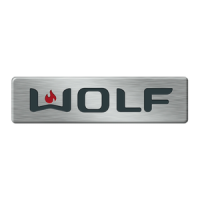
Do you have a question about the Wolf CGU-2K-24 and is the answer not in the manual?
| Model | CGU-2K-24 |
|---|---|
| Heating Capacity | 24 kW |
| Efficiency | 95% |
| Nominal heat output 80/60 °C | 24 kW |
| Fuel Type | Natural gas or propane |
| Type | Condensing gas boiler |
| Protection class | IPX4 |
Safety advice for gas detection, including immediate actions and precautions against ignition sources.
Procedure to follow upon detecting flue gas, emphasizing system shutdown and ventilation.
Instructions for safe fuse replacement, highlighting the need to isolate the boiler from mains supply.
Information on automatic frost protection while the boiler is on and the necessity of draining if needed.
Warning regarding potential ice formation on balanced flue systems and the associated risks of injury or damage.
Guidelines for proper boiler placement, ventilation, and restrictions on modifying gas components.
Advice to avoid cleaning agents, solvents, and other chemicals that may cause corrosion.
Recommendations for managing water hardness to prevent scaling and optimize DHW temperature.
Instructions for cleaning the boiler casing using mild agents, and emphasizing professional cleaning for components.
Information on the user's obligation for regular maintenance and safe procedures during servicing.
Procedure for filling the heating system with water and ensuring correct system pressure (1.5-2.5 bar).
Instructions to ensure shut-off valves for heating flow and return are open before operation.
Diagram and explanation of shut-off valves, gas ball valve, and fill/drain connections.
Regularly checking system pressure and advice against using water additives to prevent damage.
Explanation of different states indicated by the illuminated signal ring (standby, running, fault).
Details on summer/winter modes, emissions test mode, and DHW/heating water temperature selectors.
Tips for efficient heating, including using low return temperatures and weather-compensated controls.
Advice on setting accurate room temperatures and using room thermostats for energy saving.
Importance of clear airflow around radiators and room temperature sensors for optimal performance.
Measures to reduce heat loss, such as closing shutters and curtains, and improving insulation.
Guidance on effective ventilation techniques to conserve heat stored in the building.
Regular radiator venting to ensure efficient heat distribution and thermostat responsiveness.
Recommendations for controlling DHW circulation pumps using time switches based on demand.
Setting DHW temperature appropriately, with specific limits for water hardness over 15°d.H.
Tips for conserving hot water, such as showering instead of bathing and repairing dripping taps.
Procedure for identifying faults via the signal ring, reading codes, and restarting the boiler.
Information on the electronic flue gas monitor and automatic shutdown in case of flue gas escape.
